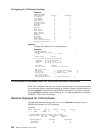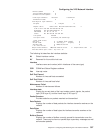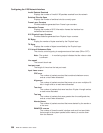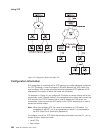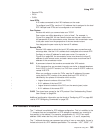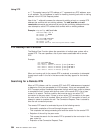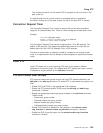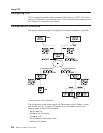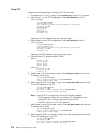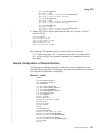
or “*”. The special case of a DTE address of “*” represents any DTE address, even
a null address. The null address is useful for handling incoming calls with no calling
address in the X.25 Call Request packet.
Use of the “*” wildcard increases the chances for adding a local or a remote DTE
address that conflicts with an existing address. The add local-dte and add
remote-dte commands are enhanced to provide the conflicting address when the
user attempts to add a DTE address that conflicts with an existing address.
Example: xtp config> add local-dte
Interface number [0]? 1
DTE address [ ] 123456
DTE address [ ]?
XTP config>add local-dte
Interface number [0]?1
DTE address [ ]?1*
DTE address conflicts with existing DTE address 123456
XTP Backup Peer Function
The Backup Peer Function allows the association of multiple peer routers with a
remote DTE. The user specifies a list of peer routers associated with a remote
DTE.
Example:
XTP config>add rem
DTE address [ ]?123456
Peer router's internal IP Address [0.0.0.0]?10.0.0.2
Peer router's internal IP Address [0.0.0.0]?10.0.0.4
Peer router's internal IP Address [0.0.0.0]?11.0.0.1
Peer router's internal IP Address [0.0.0.0]?
When an incoming call for the remote DTE is received, a connection is attempted
through each router in the list in the same order that they appear for the remote
DTE.
Searching for a Remote DTE
When a DTE initiates a call for a remote DTE, both DTE addresses are inspected
to determine if they are acceptable for X.25 transport. If they are acceptable, the
X.25 Transport protocol forwarder determines through which peer router to attempt
to complete the call. It starts with the first router in the remote DTE’s list of peer
routers in its search. The first condition that must be met is an active TCP
connection to the peer router. If there is not an active TCP connection to the peer,
the next router in the list is checked. When an active TCP connection is found, an
attempt is made to complete the call. The Connection Request Timer is started to
time the call connection process.
The remote DTE search is terminated by one of the following events:
v Successful completion of the call through the peer router
This completes call setup processing and ends the search for the remote DTE.
v Rejection of the call by the peer router
This causes the search for the remote DTE to proceed to the next router in the
peer router list.
v Expiration of the Connection Request Timer
Using XTP
364
MRS V3.2 Software User’s Guide



